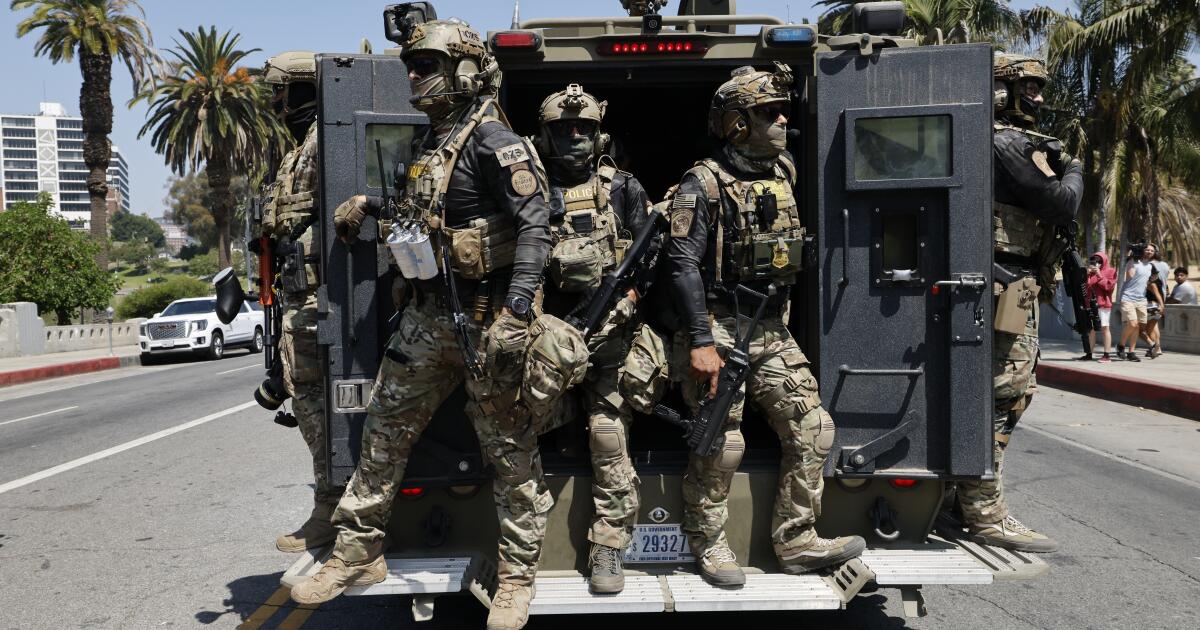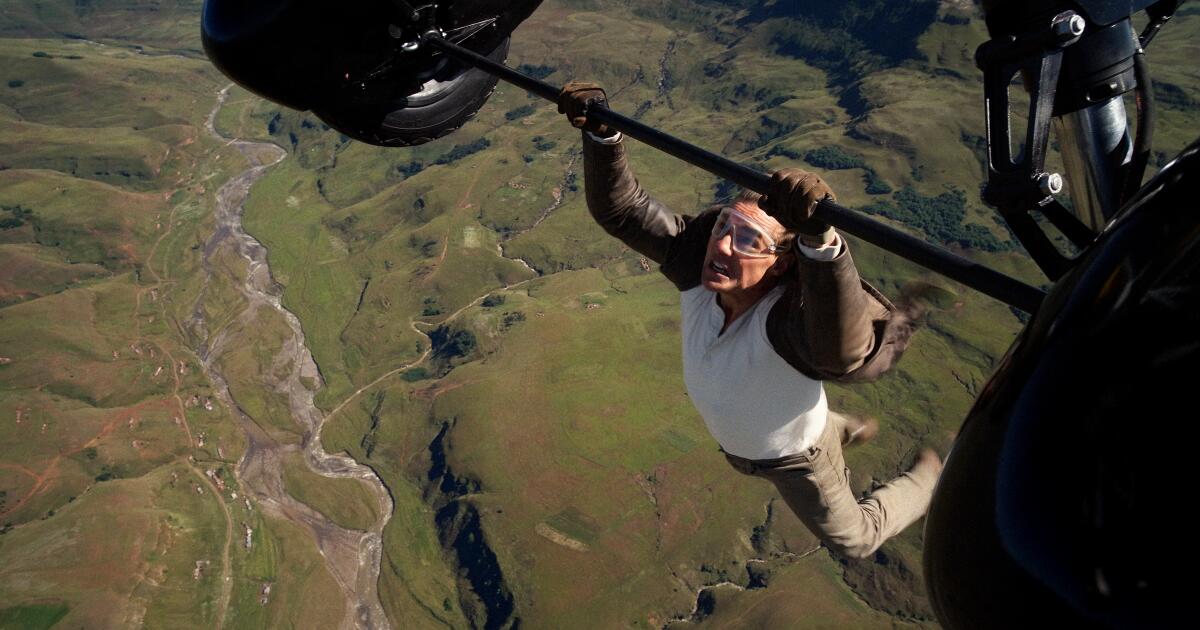Contributor: Stunts in L.A. show Democratic states and cities that Trump’s forces can invade anytime
Early this month, the U.S. military and masked federal agents from Immigration and Customs Enforcement and from Customs and Border Protection invaded a park near downtown Los Angeles — ironically, a park named after Gen. Douglas MacArthur. They came ready for battle, dressed in tactical gear and camouflage, with some arriving on horseback, while others rolled in on armored vehicles or patrolled above in Black Hawk helicopters. Although the invasion force failed to capture anyone, it did succeed in liberating the park from a group of children participating in a summer camp.
The MacArthur Park operation sounds like a scene from “South Park,” but it really did happen — and its implications are terrifying. As Gregory Bovino, the Border Patrol agent in charge, said to Fox News: “Better get used to us now, ’cause this is going to be normal very soon. We will go anywhere, anytime we want in Los Angeles.” And President Trump is sending the same message to every Democratic governor and mayor in America who dares oppose him. He will send heavily armed federal forces wherever he wants, whenever he wants and for any reason.
The United States stands at the threshold of an authoritarian breakthrough, and Congress and the courts have given Trump a lot of tools. He’s learned from Jan. 6, 2021, that he needs tight control over the “guys with the guns,” as retired Joint Chiefs Chairman Mark Milley put it. And that’s what he got when Congress dutifully confirmed Trump loyalists to lead all of the “power ministries” — the military, the FBI and the Department of Justice, the rest of the intelligence community and the Department of Homeland Security.
As commander in chief, the president can deploy troops and, under Title 10, he can also put National Guard troops under his command — even against the wishes of local officials. Gov. Gavin Newsom challenged the legality of Trump’s exercise of this authority in Los Angeles last month, and we will see what the courts say — but based on its initial rulings, the Court of Appeals for the 9th Circuit appears likely to defer to the president. Under the Posse Comitatus Act, the troops cannot currently enforce laws, but Trump could change that by invoking the Insurrection Act, and we have to assume that the current Supreme Court would defer to him on that as well, following long-standing precedents saying the president’s power under the act is “conclusive.”
Trump could send the military into other cities, but the most dangerous weapon in his authoritarian arsenal might be the newly empowered Department of Homeland Security, which has been given $170 billion by Congress to triple the size of ICE and double its detention capacity.
No doubt, this will put Trump’s “mass deportation” into overdrive, but this is not just about immigration. Remember Portland in 2020, when Trump sent Border Patrol agents into the city? Against the wishes of the Oregon governor and the Portland mayor, the president deployed agents to protect federal buildings and suppress unrest after the killing of George Floyd. Under the Homeland Security Act, the secretary can designate any employee of the department to assist the Federal Protective Service in safeguarding government property and carrying out “such other activities for the promotion of homeland security as the Secretary may prescribe.”
Under that law, DHS officers can also make arrests, on and off of federal property, for “any offense against the United States.” This is why, in 2020, Border Patrol agents — dressed like soldiers and equipped with M-4 semi-automatic rifles — were able to rove around Portland in unmarked black SUVs and arrest people off the streets anywhere in the city. Trump could do this again anywhere in the country, and with the billions Congress has given to immigration and border agencies, DHS could assemble and deploy a formidable federal paramilitary force wherever and whenever Trump wishes.
Of course, under the 4th Amendment, officers need to have at least reasonable suspicion based on specific, articulable facts before they can stop and question someone, and probable cause before they arrest. And on Friday, U.S. District Judge Maame Ewusi-Mensah Frimpong issued a temporary restraining order blocking ICE and Customs and Border Protection from making such stops without reasonable suspicion, and further holding that this could not be based on apparent race or ethnicity; speaking Spanish or speaking English with an accent; presence at a particular location, such as a Home Depot parking lot; or the type of work a person does. This ruling could end up providing an important constitutional restraint on these agencies, but we shall see. The Trump administration has appealed the ruling.
However, this litigation proceeds, it is important to note that the DHS agencies are not like the FBI, with its buttoned-down, by-the-book culture drilled into it historically and in response to the revelations of J. Edgar Hoover’s abuses of power. DHS and its agencies have no such baggage, and they clearly have been pushing the envelope in Los Angeles — sometimes brutally — over the last month. And even if Frimpong’s ruling stands up on appeal, ICE and Customs and Border Protection will no doubt adapt by training their officers to articulate other justifications for stopping people on the street or in workplaces. Ultimately, these agencies are used to operating near the border, where, in the late Chief Justice William Rehnquist’s words, the federal government’s power is “at its zenith,” and where there are far fewer constitutional constraints on their actions.
These are the tools at Trump’s disposal — and as DHS rushes to hire thousands of agents and build the detention facilities Congress just paid for, these tools will only become more formidable. And one should anticipate that Trump will want to deploy the DHS paramilitary forces to “protect” the 2026 or 2028 elections, alongside federal troops, in the same way they worked together to capture MacArthur Park.
A fanciful, dystopian scenario? Maybe, but who or what would stop it from happening? Congress does not seem willing to stand up to the president — and while individual federal judges might, the Supreme Court seems more likely to defer to him, especially on issues concerning national security or immigration. So, in the words of Bruce Springsteen, “the last check on power, after the checks and balances of government have failed, are the people, you and me.” Suit up.
Seth Stodder served in the Obama administration as assistant secretary of Homeland Security for borders, immigration and trade and previously as assistant secretary for threat prevention and security. He teaches national security and counterterrorism law at USC Law School.

